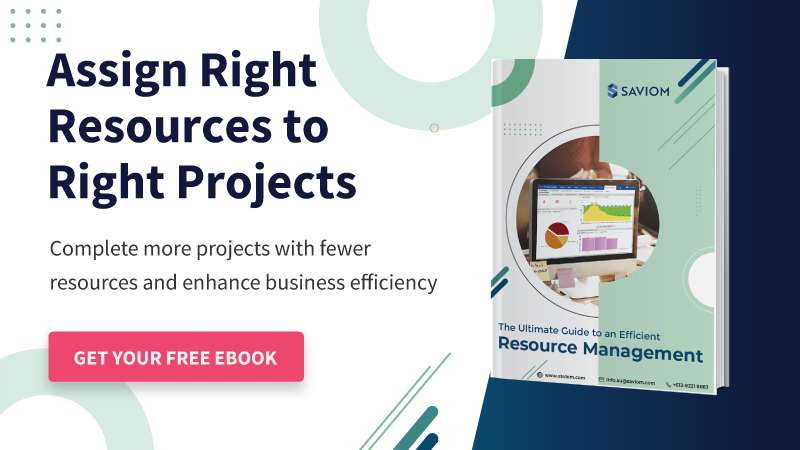Resource scheduling is an essential component of project management. It involves assigning resources to tasks that have a definite start and end date. These resources can be human labor, equipment, machinery, etc. They are scheduled based on their skill set, experience, and capacity.
With the help of efficient resource scheduling, project managers can avoid over/underutilization of resources.
Since they will be assigned based on their availability, managers can ensure optimal usage. In addition, it will also help build resource morale, improve engagement, increase productivity, and boost stakeholder satisfaction.
Resources must be onboarded as per the plan, failing which there will be a delay in completing tasks on time and even the entire project can come to a halt. This blog explains how one can plan scheduling resources that ensure business profitability.
But first, let’s start with the basics.
What is Project Planning?
To complete any endeavor, you will need to have a proper plan. For instance, if you want to conduct a dinner party, you must formulate a practical arrangement. It may entail noting down a list of the invitees, party themes, restaurants, food and beverages, etc. Without a well-documented plan, you may not be able to host a successful dinner party.
Likewise, in the project management field, proper project planning is crucial. During this phase, the project manager will create a document that describes how the project will be executed, monitored, and closed. In addition, it will outline the goals and objectives of the project and serve as an official point of reference for the team members and stakeholders.
The project plan discusses all the constraints, i.e., time, budget, scope, resources, risks, and quality. Besides, the milestones, deliverables, contingency plans are also identified in this phase. Thus, it assists in determining what needs to be done, who will do what task, and how the whole project will be implemented.
Simply put, project planning helps develop a roadmap of the project and identify every aspect of the project. Besides, the plan enables senior management to monitor and track project progress and take necessary steps.
Read More: How to Create An Effective Project Plan in 9 Simple Steps?
Role of Resource Scheduling in Project Planning
During project planning, the PM creates the work breakdown structure (WBS) and assigns available resources to individual tasks. The assignment is done by matching the skill requirement and competencies of the resources for the specific tasks. The job of the PM is also to ensure that the resources are fully utilized and there is little idle time.
In addition, effective resource scheduling allows the project manager to verify any shortages or excess of resources against the previously estimated resource requirements.
For instance, let’s assume that you are heading a content marketing project. You had done the resource estimations and requested 10 content writers and 15 graphic designers. Following that, the resource manager allocated all the required resources. But while scheduling them to different tasks, you find out that seven writers and ten designers would be enough.
Thus, you can inform the resource manager in advance and release excess resources from the project so that they are duly allocated to other suitable opportunities to avoid billing loss. Similarly, if project managers underestimate resource requirements and identify the shortages while scheduling, they can request additional workforce from the concerned resource manager.
Implementing efficient resource scheduling will help test your current project estimations and enable you to align future assessments with reality.
Steps of Resource Scheduling in Project Planning
Here is a detailed description of the ways to formulate an effective resource scheduling plan:
Ascertain resource requirements for tasks
After creating the WBS and identifying the tasks, sub-tasks, activities, etc., you’ll need to determine the resources for those tasks. For instance, if you are heading a software development project, the resources required would be developers, designers, programmers, etc. Based on that, you can determine the quality and quantity of resources. Moreover, you can consult with SMEs to understand the skill set requirements needed to execute the project.
Firstly, you should identify the critical task resource requirements. Since the project’s duration will depend on these tasks, you may need experienced and highly skilled resources for them. Following that, you can recognize the other resources.
Based on the requirements, you can forward resource requests to the resource manager. Depending on the ramp-up or ramp-down stages, you may send the requests at once or in a staggered manner.
Avail complete visibility of all resources
After getting the resource requests, the onus is on the resource managers to act on them. They have to find the right resources for those tasks before the project begins. But in a matrix organization or a big firm, the resources are scattered over different locations. Besides, they may be working on multiple projects and have numerous reporting lines at the same time. As a result, resources can get overwhelmed with the workload and have minimum availability.
A resource management solution provides 360-degree visibility across the whole enterprise. Resource managers can determine resource capacity, availability, skills, and every other resource attribute. Based on that, they can identify appropriate resources and match them with the requirements. The solution helps in eliminating the cumbersome silos of spreadsheets and provides a single version of the truth.
Moreover, resource managers can identify shortages or excess of resources and take appropriate measures. They can also leverage cost-effective global resources from low-cost locations. It will help in saving resourcing costs without compromising project quality.
Read More: Top Ten Business Benefits of Resource Management
Create a resource risk mitigation plan
There are plenty of resource-related risks that can plague the project. Some of these risks are unplanned leaves, sudden attrition, etc. As the project manager, the onus is to identify these risks, calculate their impact, and eliminate them before they become issues and derail projects off the track.
You may create a risk register where you can list down all the potential threats. Following that, you can develop a risk assessment plan to determine the type and effect of the risks. Based on that, you may formulate a risk mitigation plan to eliminate them.
Besides, you may also create a succession plan for all the critical resources if they leave the project or resign from the company. With this plan, you can put some resources on reserve and keep them updated with all the project information. If a critical resource leaves, you can deploy a reserved resource to their place. It will help in ensuring that the project stays on track and the deliverables are not affected.
Assign competent resources to tasks
After everything is said and done, you have received the resources as per your requirements. You may schedule them to the tasks based on the tasks duration, criticality, and seniority of the resources. You must also ensure that the resources understand the project goals and have clarity over their responsibilities. It will help in avoiding any unnecessary conflicts.
Moreover, you should ensure that the resources scheduled are not over or underwhelmed. If a less-experienced resource is given a critical task, they will be burned out and eventually leave the project. In addition, it results in schedule overruns as a junior resource will take more time to complete a critical task.
On the contrary, a senior resource will feel disrespected and undervalued if assigned to mundane or low-priority work. As a result, the resource will look for better opportunities and may leave the project or resign from the company.
Read More: How do project managers deal with unplanned leaves?
Optimize resource schedules if needed
Optimizing a resource’s schedule is necessary to ensure desired productivity and successful delivery of projects. As a project manager, you can form a balanced project resource schedule in two ways. For instance, you can adjust the project deadline according to the critical resource’s capacity, known as resource-leveling. Or, you may even pull in more resources to redistribute the tasks without deviating from the timeline.
The application of both these techniques will be dependent on the flexibility or rigidity of the project’s timeline. In case project deadlines are flexible, you will have the liberty to prolong the duration. That way, you can exercise resource leveling and match the project’s timeline with the resource’s availability.
Otherwise, resource smoothing techniques can be used when project deadlines are stringent and cannot be adjusted. For example, you may assess the resources’ workload, and if they are prone to overutilization, you can redistribute their workload or pull in additional resources to balance it out.
Read More: How Resource Optimization Boosts Task Management?
Conclusion
Resource scheduling assists in creating a perfect project plan. It helps you to assign the right resources and meet the resource demands. Moreover, once the project starts, you can monitor their performance and track their utilization. Based on that, you may identify task delays, reshuffle tasks, and ensure optimal usage.
In a nutshell, with expert resource scheduling techniques and tools, you can determine tasks, find relevant resources, and deliver projects on time and within budget.
Saviom Solution
SAVIOM has over 20 years of experience helping multinational clients manage their resources efficiently and effectively. With over 20 years of experience, this Australian-based MNC has a global presence across 50 countries and has helped 100+ clients meet their specific business goals. Saviom also provides tools for project portfolio management, professional service automation, and workforce planning software. So, SAVIOM can help your business to establish an efficient system geared towards your specific business challenges.












